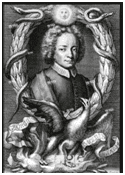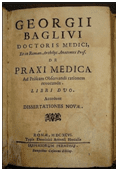

Giorgio Baglivi (1668-1707) contributed much to our understanding of muscle structure and function, as well as publishing classic descriptions of pulmonary edema and other disorders. Born Duro Armeno in the Republic of Ragusa (now Dubrovnik), he was probably of Armenian descent. His parents dying when he was young, he left for southern Italy, where adopted by Pietro Angelo Baglivi, a physician in Lecce, he took his surname and also followed his profession. After obtaining his medical degree he began medical practice with his foster father, then worked in hospitals in Padua, Venice, and Florence before finally settling in 1691 in Bologna as pupil and later assistant of Marcello Malpighi .
When Malpighi was called to Rome to serve as physician to Pope Innocent XII, he effectively became the Pope’s second physician. He was elected professor of anatomy and physician-in-chief of practical medicine at the Sapienza University , and rapidly joined the ranks of Rome’s elite physicians and medical scientists. In addition to his active practice, Baglivi continued his work in experimental physiology and microscopy,
studying the structure and function of various organs, especially the heart and lungs. He first differentiated smooth from striated muscle, and thought that the heart beats independently of vagal or other innervation. In 1696, Baglivi published an important book on medical practice, De praxi medica, which was translated into English eight years later. He left masterful descriptions of pulmonary edema, stating that if a patient wakes of a sudden shortness of breath and presently runs to the window in quest of the free air, “you may rest assured that he has a dropsy in his breast, especially if his hands or feet begin to swell…”
Baglivi also wrote about the structure of medical practice and the state of medical education, proposing specialization in medicine and advocating the creation of a college of physicians to improve the practice of medicine. Beyond medicine he also was interested in geology, mineralogy, oceanography, and zoology. While in Rome in 1694 he reported on the necropsy he performed on the body of his former chief Marcello Malpighi, and found that he had died from a cerebral hemorrhage, probably secondary to renal hypertension, his right kidney being normal but the left shrunken and its pelvis dilated.

Leave a Reply